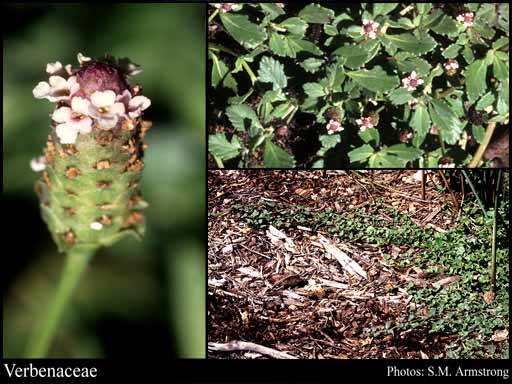- Reference
- Expos.Fam.Nat. 1:245 (1805)
- Name Status
- Current

Scientific Description
Common name. Verbena Family.
Habit and leaf form. Trees, shrubs, and herbs, or lianas (many); bearing essential oils. ‘Normal’ plants and switch-plants; sometimes with the principal photosynthesizing function transferred to stems. Leaves well developed, or much reduced (occasionally). Young stems tetragonal (often), or cylindrical, or oval in section. Self supporting, or climbing; the climbers stem twiners, or scrambling. Clerodendrum twining clockwise. Mesophytic and xerophytic. Leaves opposite (usually), or whorled, or alternate (rarely); petiolate to sessile; aromatic, or without marked odour, or foetid; simple, or compound; epulvinate; when compound, ternate to pinnate (e.g.Vitex), or palmate. Leaf blades dissected, or entire; when dissected, pinnatifid; pinnately veined; cross-venulate. Leaves without stipules; without a persistent basal meristem. Domatia recorded (4 genera); represented by pits, or pockets, or hair tufts. Stem anatomy. Nodes unilacunar (1–several traces). Secondary thickening developing from a conventional cambial ring.
Reproductive type, pollination. Fertile flowers hermaphrodite. Unisexual flowers absent. Plants hermaphrodite (usually). Entomophilous.
Inflorescence and flower features. Flowers usually aggregated in ‘inflorescences’; in cymes, in racemes, in spikes, in heads, and in verticils. The terminal inflorescence unit cymose, or racemose. Inflorescences terminal, or axillary; with involucral bracts (often, these commonly coloured), or without involucral bracts; pseudanthial (sometimes), or not pseudanthial. Flowers bracteate; small to medium-sized; very irregular (usually), or regular to somewhat irregular. The floral asymmetry involving the perianth and involving the androecium. Flowers (4–)5(–8) merous; cyclic; tetracyclic. Free hypanthium absent. Hypogynous disk present, or absent; when present, annular. Perianth with distinct calyx and corolla; (7–)10(–16); 2 -whorled; isomerous, or anisomerous. Calyx (2–)5(–8); 1 -whorled; gamosepalous; entire, or lobed; unequal but not bilabiate, or regular; persistent; when K5, with the median member posterior. Corolla (4–)5(–8); 1 -whorled; gamopetalous; imbricate; tubular (usually), or campanulate (rarely); unequal but not bilabiate, or bilabiate, or regular (rarely). Androecium (2–)4(–5). Androecial members adnate (to the corolla tube); markedly unequal (usually), or all equal (rarely); free of one another; 1 -whorled. Androecium exclusively of fertile stamens, or including staminodes. Staminodes when present, 1–3; non-petaloid. Stamens (2–)4(–5) (the posterior member usually, and sometimes the three upper members, reduced or missing). Staminal insertion near the base of the corolla tube, or midway down the corolla tube, or in the throat of the corolla tube. Stamens usually didynamous; reduced in number relative to the adjacent perianth (usually), or isomerous with the perianth; oppositisepalous; all alternating with the corolla members. Anthers connivent (in pairs), or separate from one another; dorsifixed; dehiscing via longitudinal slits; introrse; tetrasporangiate. Gynoecium 2 carpelled (usually), or 4 carpelled, or 5 carpelled. The pistil 2–10 celled. Carpels reduced in number relative to the perianth (usually), or isomerous with the perianth. Gynoecium syncarpous; eu-syncarpous; superior. Ovary plurilocular; 2 locular, or 4 locular, or 8 locular, or 10 locular (the original locules (usually two) early becoming divided by a ‘false septum’ in each — cf. Lamiaceae). Locules secondarily divided by ‘false septa’. Gynoecium usually median; stylate. Styles 1; attenuate from the ovary, or from a depression at the top of the ovary (but the ovary apex no more than slightly lobed); apical, or lateral. Stigmas 1; 1 - lobed, or 2 - lobed; wet type; papillate; Group III type and Group IV type. Placentation axile, or basal to axile. Ovules 2 per locule (in the true locules), or 1 per locule (in the secondary locules); pendulous, or horizontal, or ascending (but micropyle always inferior); non-arillate; orthotropous, or hemianatropous, or anatropous.
Fruit and seed features. Fruit fleshy (usually), or non-fleshy; dehiscent (rarely), or indehiscent, or a schizocarp. Mericarps when schizocarpic comprising nutlets, or comprising drupelets. Fruit when non-schizocarpic a drupe (usually), or a capsule. Capsules valvular (with 2–4 valves). Seeds non-endospermic. Cotyledons 2 (expanded, flat). Embryo achlorophyllous (5/5); straight. Seedling. Germination phanerocotylar, or cryptocotylar.
Physiology, biochemistry. Aluminium accumulation not found. Photosynthetic pathway: C3.
Special features. The upper lip of the corolla incorporating 2 members, the lower 3, or incorporating 4 members, the lower 1, or suppressed, the lower incorporating all five members.
Geography, cytology, number of species. World distribution: very widespread temperate and tropical, but absent from central and Northern Eurasia. X = 5–12. 3000 species.
Economic uses, etc. Timber from Tectona grandis (teak); some notable ornamentals, e.g. Clerodendrum, Callicarpa, Vitex, Lantana, Verbena; noxious, photosensitizing weeds (Lantana).
Additional comments. For comment on the taxonomically unsatisfactory circumscription of Verbenaceae employed here, see remarks under Lamiaceae.